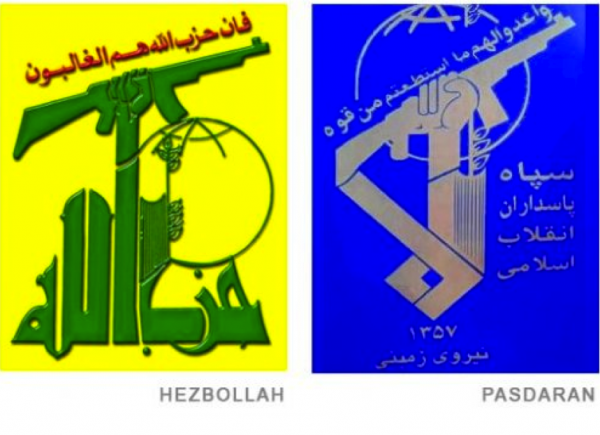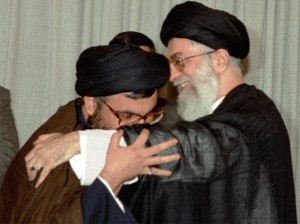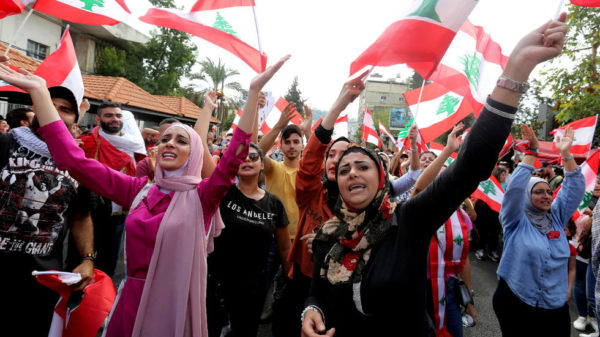
Hezbollah is part of the Qods force which in turn is the foreign arm of Pasadran. Top Iranian cleric Ayatollah Ahmad Alamolhoda declared last month that Iran is bigger than the “geographical” boundaries surrounding it and that the presence of armed factions supported by Iran in the Middle East, including “Hezbollah in Lebanon, are part of Iran.”
by Hamid Enayat*
Lebanon these days is witnessing a scenario that Iraq has experienced recently, when people first took to the streets and shouted their true demands for tax cuts and the fight against corruption. However, these protests began to take on a different color and smell with the arrival of specific currents. At this point, media outlets opposed to the Hezbollah and the resistance movement entered the scene, and similar to what they had done with the Iraqi “Hashd-al Shaabi”, directed their artillery towards Hezbollah in Lebanon and tried to direct the protests towards the removal of Hezbollah from the Lebanese government structure. (Kayhan newspaper close to Khamenei October 22)
This is the perception of a media close to Khamenei of the Iraqi and Lebanese uprisings. It is true that the uprisings began with economic demands at first, but the youth who took to the streets quickly targeted the institutions affiliated with the Iranian regime. The uprising of the Iranian people began at the beginning of 2018 for high costs, unemployment and poverty, but quickly turned to the slogan of “Death to the dictator.”
The uprising of the Lebanese people on its fifth day (Monday, October 21), began with a general strike and taking of nearly 2 million people to the streets in Beirut and other Lebanese cities. The insurgents demand the fall of the ruling regime.
Mashhad Friday Sermon by Ayatollah Ahmad Alamolhoda: The PMU, Hizbullah, Ansar Allah, Hamas, Islamic Jihad, Are All Iran; We Can Destroy Israel in Half a Day pic.twitter.com/wbuXbZnyGu
— MEMRI (@MEMRIReports) September 22, 2019
Lebanon used to be the leading Arab country in terms of economic, social and cultural development, but now due to destruction by Hezbollah, a wholly-owned mullahs’ regime proxy, has gone backward and is witnessing the spread of corrupt practices from drug trafficking to unemployment, bribery, economic corruption and so on. But the Lebanese people, including followers of all religions, and especially the Shiites, who are most vulnerable to Hezbollah’s invasion, are determined to save their country.
What is happening in Lebanon has the scent of a revolution. Because all classes of people, from students and workers to employees and from urban to rural areas, participate in it. The coming of 2 million people to the streets in this country of 6 million, proves this claim.
In addition, people who are not affiliated with any known political parties or groups have so far rejected all reformist proposals and have called for the abolition of the religious and sectarian system that is blocking democracy and development in the country.
The religious and tribal classification system provided the basis for the regime’s growth and influence in Lebanon and enabled the mullahs’ regime to turn Lebanon into its own hunting ground through Hezbollah’s “Trojan horse”. But the new generations of Lebanon appear to be trying to overthrow the rotten sectarian and religious system in Lebanese society, and to see ethnic and religious diversity in Lebanon not a factor for division and chaos, but a ground to promote prosperity and growth. These features and depth and extent of the uprising in Lebanon have led some observers to call what is now happening in this Mediterranean country a revolution.

The coincidence of the Lebanese uprising with the uprising of the Iraqi people cannot be accidental, and the impact of the bloody uprising of the Iraqi people on the Lebanese people cannot be denied, especially as the aim of both uprisings is to deny the fundamentalist propaganda dominated by the Iranian regime and to dismantle the regime and its institutions. The reaction of the regime to the uprising of the Lebanese people also clearly shows that the mullahs are afraid of losing their influence in Lebanon and have struggled to block and divert it. In particular, Hezbollah has had and has a unique place in what the Supreme Leader views as the “strategic depth” of the regime.

The Iranian regime has carried out many of its assassinations and terrorist acts overseas that did not want to leave its fingerprints, from the Mykonos crime in Berlin to the Amia bombing in Buenos Aires and the likes, by Hezbollah. Moreover, Hezbollah was constantly ready to ignite the fire of war in that potentially critical region with the help of its rocket launchers and provocations, as the regime needed it, due to its funding by the Iranian regime at the expemse of the deprived people of Iran. The adventurous actions that Lebanese people have been paying a heavy price for years.
Despite the similarities between Lebanon and Iraq, but because of the different political and social characteristics of the two countries, the regime’s hands are not as open to suppress the Lebanese uprising as the Iraqi uprising. In Iraq, the Revolutionary Guards under the command of Qassem Soleimani, were killing Iraqi protesters by snipers, but in Lebanon, the regime has no such opportunity, and the army has declared solidarity with the people, giving a clear perspective to the uprising in Lebanon.
Regime propaganda against the Lebanese uprising
In its official propaganda, the regime, in line with its approach to the Iraqi uprising, minimized the uprising of the Lebanese people and considers it incited by “foreign blackmail” through cyberspace. The regime’s propaganda apparatus is also trying to divert Lebanese anger and rebellion against Hezbollah and its leader to other officials and politicians in Lebanon.
Javan Newspaper, affiliated with the IRGC, wrote on October 21: “The Hariri government, that for years has prevented serious work by the united resistance current and its allies with poor management, and itself is a cause of the situation, has presented a plan for reform with the support of France and the US, that has focused on critical areas such as telecommunications in the name of privatization, which in particular is an attempt to remove intelligence dominance of Hezbollah, which has had the country’s telecommunications for years based on tribal agreement … “.
This state-run newspaper’s acknowledgment of Hezbollah’s “intelligence dominance” through its possession of the Lebanese Ministry of Telecommunications gives pause for reflection. Interestingly, however, the spark of the revolution was lit by the work of the same ministry that sought to impose a new tax on internet communications.
Thus, the Lebanese uprising has raised the second alarm after the Iraqi uprising for the Iranian fundamentalist regime, and its message is that the anti fundamentalist front is emerging with its arms cut in Iraq and Lebanon.
*Hamid Enayat is an Iranian human rights activist and analyst based in Europe.
EURASIA
Leave a Reply
You must be logged in to post a comment.